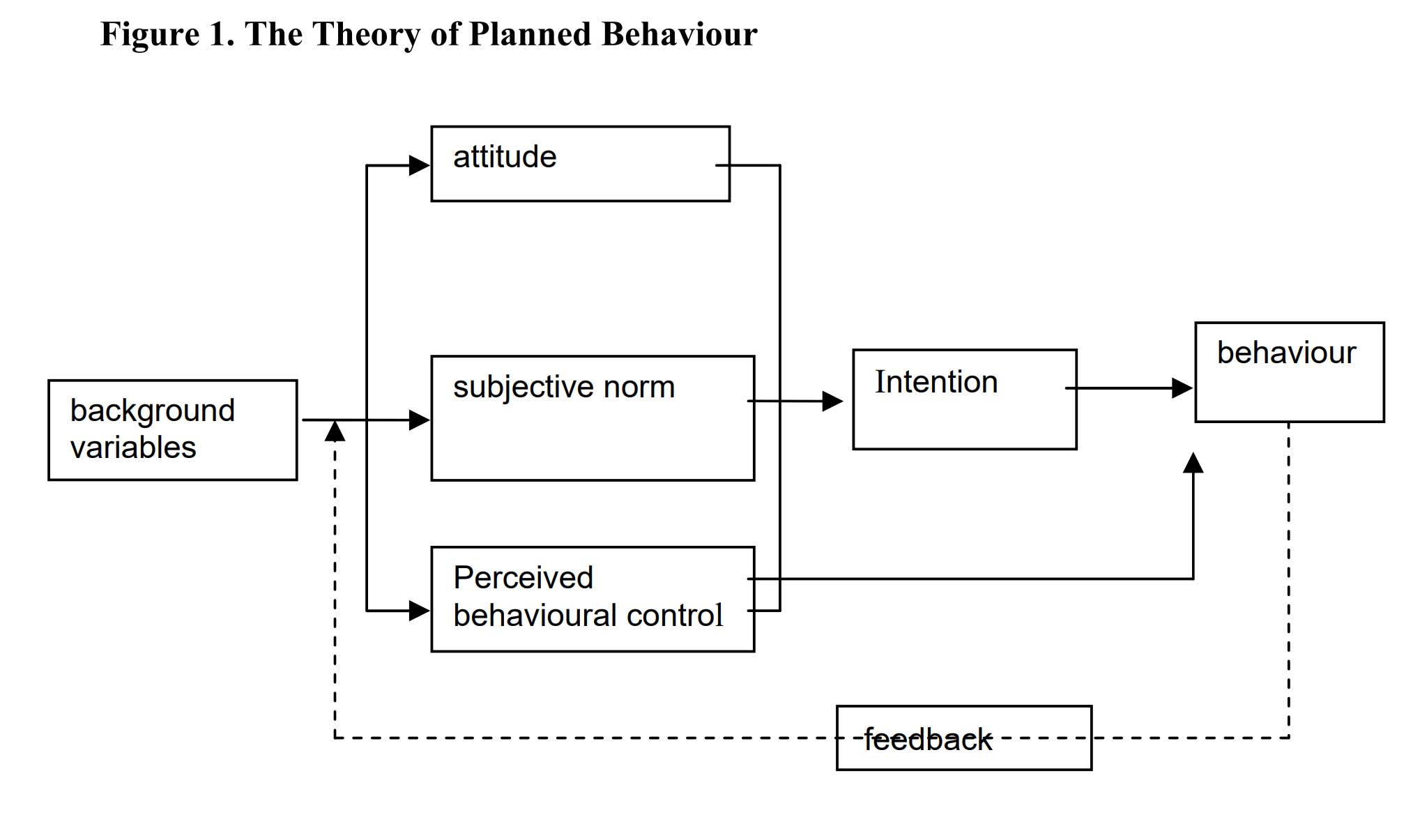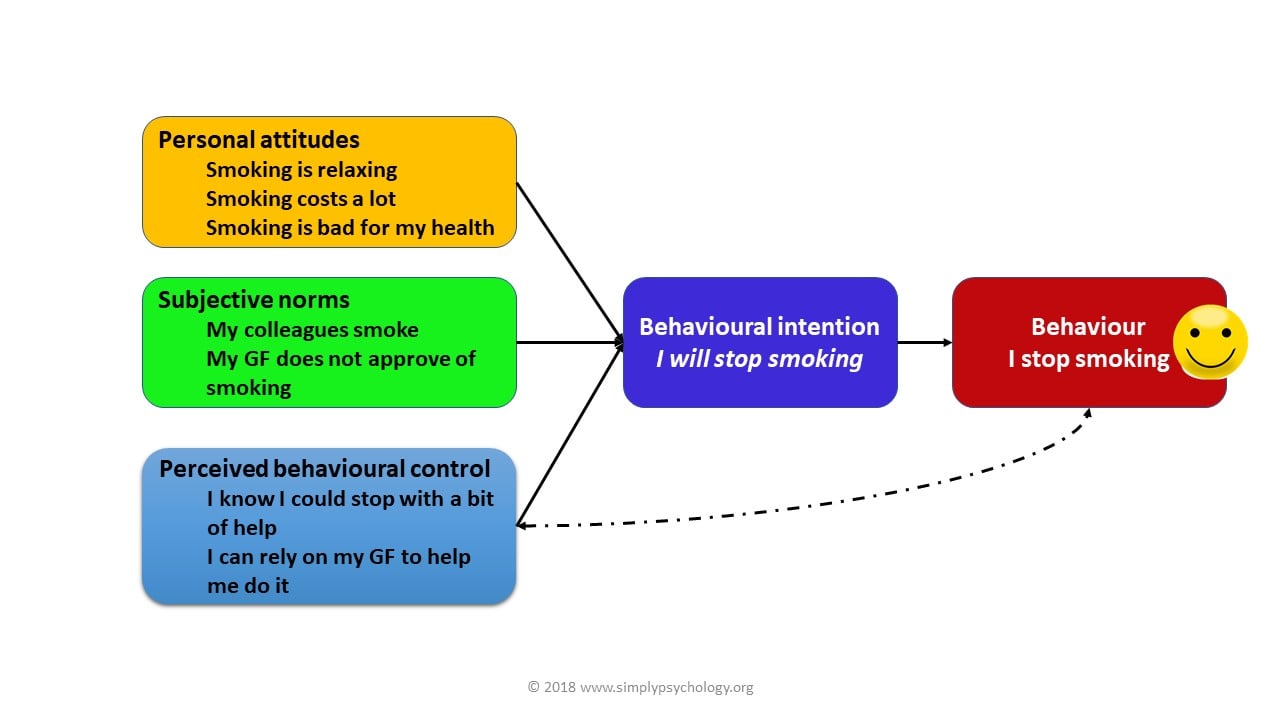On This Page:
The theory of planned behavior (TPB) is a cognitive theory by Azjen (1985) that proposes that an individual’s decision to engage in a specific behavior, such as gambling or stopping gambling, can be predicated by their intention to engage in that behavior (Fig. 1).
“Intentions are assumed to capture the motivational factors that influence behavior; they are indications of how hard people are willing to try, of how much of an effort they are planning to exert, in order to perform the behavior.
As a general rule, the stronger the intention to engage in a behavior, the more likely should be its performance” (Ajzen, 1991, p. 181).
Variables
According to TPB, intentions are determined by three variables:
1. Personal attitudes
This is our personal attitude towards a particular behavior. It is the sum of all our knowledge, attitudes, and prejudices …. positive and negative, that we think of when we consider the behavior.
For example, our individual attitude to smoking might include tobacco is relaxing and makes me feel good, but it makes me cough in the morning, costs a lot of money, and smells bad.
2. Subjective norms
This considers how we view the ideas of other people about a specific behavior, e.g., smoking. This could be the attitude of family and friends, and colleagues toward smoking. It is not what other people think but our perception of others’ attitudes.
3. Perceived behavioral control
This is the extent to which we believe we can control our behavior.
This depends on our perception of internal factors, such as our own ability and determination, and external factors, such as the resources and support available to us. The theory argues that our perception of behavioral control has two effects:
It affects our intentions to behave in a certain way, i.e., the more control we think we have over our behavior, the stronger our intention to perform it.
It also affects our behavior directly; if we perceive that we have a high level of control, we will try harder and longer to succeed.
The present view of perceived behavioral control, however, is most compatible with Bandura’s (1977, 1982) concept of perceived self-efficacy, which is concerned with judgments of how well one can execute courses of action required to deal with prospective situations (Bandura, 1982, p. 122).

The theory of planned behavior is an extension of the theory of reasoned action (Ajzen & Fishbein, 1980; Fishbein & Ajzen, 1975)
According to the theory of planned behavior, perceived behavioral control, together with behavioral intention, can be used directly to predict behavioral achievement.
Health Applications
TPB has practical applications; it has been used in health education campaigns. Anti-drug campaigns often give data about the percentage of people engaging in risky behavior such as smoking or drug use to change the subjective norm.
For example, teenagers who smoke are usually part of a peer group who smoke. Therefore they might think smoking is the norm. However, most teenagers don’t smoke, so exposure to statistics showing them the true extent of smoking should change their subjective norm.

Applying the Theory of Planned Behavior to Smoking
TPB is the model most used in health psychology. It has been useful in predicting intentions relating to smoking and drinking, as supported by Hagger et al. (2011).
He found that the three components of the model (personal attitudes, subjective norms, and perceived behavioral control) correlated with alcohol addicts’ intentions to limit or stop their drinking.
He also found that those intentions were reflected in their behavior and could predict the approximate number of units consumed after 1 and 3 months. However, it did not predict binge drinking.
Penny (1996) found that smokers were less likely to believe they would quit smoking and therefore were less likely to try the more times they have failed to quit previously. This shows the importance of perceived behavioral control in shaping our intentions, as predicted by TPB.
However, Webb et al. (2006) carried out a meta-analysis of 47 studies and found that although there is a link between intention and actual behavior, that link is small.
This suggests that there is a significant gap between intentions and behavior.
Critical Evaluation
There are methodological problems associated with research on this theory.
All the components of the model are assessed using questionnaires or interviews, so the answers are influenced by social desirability.
Furthermore, these interviews or questionnaires are done when the participants are not under the influence of drugs/ alcohol, but when they are in situations that trigger their addiction behavior (pub, party ….), their intentions might soon be forgotten, and the behavior resumed.
A strength of TPB is that it takes into account the influence of peers (subjective norms), which is significant in both the beginning of the behavior and its maintenance (SLT and operant conditioning ).
The theory of planned behavior assumes that all behaviors are conscious, reasoned, and planned; however, it does not consider the role of emotions such as sadness, frustration … which can play an important role in influencing behavior.
References
Ajzen, I. (1985). From intentions to actions: A theory of planned behavior. In J. Kuhi & J. Beckmann (Eds.), Action-control: From cognition to behavior (pp. 11ó39). Heidelberg: Springer.
Ajzen, I. (1991). The theory of planned behavior. Organizational behavior and human decision processes, 50 (2), 179-211.
Ajzen, 1., & Fishbein, M. (1969). The prediction of behavioral intentions in a choice situation. Journal of Experimental Social Psychology, 5, 400-416.
Ajzen, I., & Fishbein, M. (1970). The prediction of behavior from attitudinal and normative variables. Journal of Experimental Social Psychology, 6, 466-487.
Ajzen, I., & Fishbein, M. (1977). Attitudeóbehavior relations: A theoretical analysis and review of empirical research. Psychological Bulletin, 84, 888-918.
Ajzen, I., & Fishbein, M. (1980). Understanding attitudes and predicting social behavior. Englewood Cliffs, NJ: Prentice Hall.
Fishbein, M., & Ajzen, 1. (1975). Belief, attitude, intention, and behavior: An introduction to theory and research. Reading, MA: Addison – Wesley

